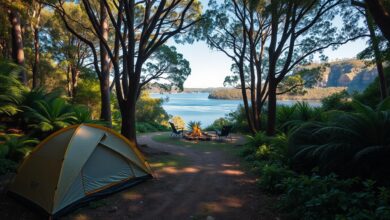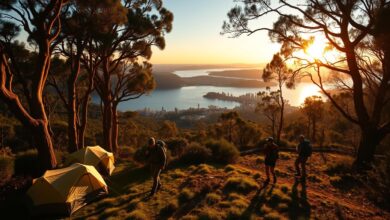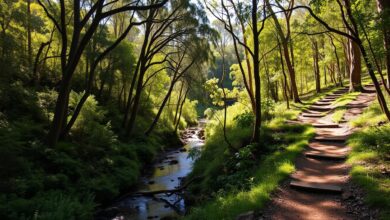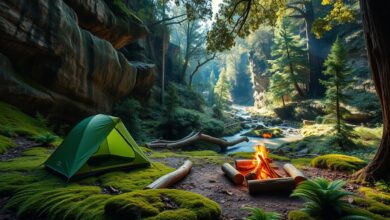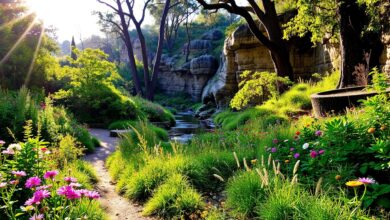The Blue Mountains are famous for their stunning views and rich wildlife. They are perfect for those who love camping and hiking. Here, you can really connect with nature and see the beauty of Australia up close.
For a great trip, you need to be well-prepared. This guide will cover all the basics. You’ll learn about the gear you need and how to stay safe.
Key Takeaways
- Discover the best camping and hiking spots in the Blue Mountains.
- Learn about the essential gear required for a safe and enjoyable trip.
- Understand the safety tips and precautions to take while hiking and camping.
- Explore the diverse wildlife and breathtaking landscapes of the region.
- Plan your trip according to the best times to visit the Blue Mountains.
Introduction to the Blue Mountains
The Blue Mountains are in the heart of Australia. They are known for their stunning landscapes. People from all over come here to hike, camp, and explore.
Overview of the Region
The Blue Mountains have steep cliffs, deep valleys, and pretty villages. They are covered in lush eucalyptus forests. This creates a home for many native animals.
The terrain is perfect for outdoor fun. You can hike, rock climb, and camp here.
Importance of Outdoor Activities
Outdoor activities in the Blue Mountains are more than fun. They help us connect with nature and see the area’s wildlife. Hiking and camping let visitors enjoy the beauty of the area.
These activities are good for your body and mind. They also help us care for the environment.
Some benefits of outdoor activities in the Blue Mountains include:
- Improving physical fitness through hiking and other adventure sports
- Enhancing mental health by reducing stress and promoting relaxation
- Fostering a sense of community among participants
Best Times to Visit
The best times to visit are spring (September to November) and autumn (March to May). The weather is mild, and there are fewer people around. Spring is lovely with wildflowers, and autumn is beautiful with changing leaves.
But, the weather can be extreme, with heatwaves and bushfires. Always check the forecast and be ready with the right gear and safety.
Essential Gear for Camping
To have a comfortable and safe camping trip in the Blue Mountains, you need the right gear. The area’s rugged terrain and changing weather require careful planning.
Tent and Sleeping Bag Choices
Choosing the right tent and sleeping bag is key for a good night’s sleep. In the Blue Mountains, a waterproof and strong tent is essential. This is because of the rain and strong winds.
Look for a tent that can handle water well and is easy to set up. For sleeping bags, pick one that keeps you warm in cooler temperatures. Even in summer, it can get cold at night. Aim for a sleeping bag rated for around 5°C for comfort.
Cooking Equipment Essentials
Cooking outdoors needs portable and efficient gear. A portable camping stove is handy for easy meals. Also, bring a durable, light pot and pan set, and utensils and plates that are easy to clean.
If you like to cook more complex meals, think about a camping grill or portable barbecue. Always follow local fire safety rules and guidelines.
Safety Gear to Pack
Safety is always first when camping. A good first aid kit is a must, with bandages, antiseptic wipes, pain relievers, and any personal meds. A flashlight or headlamp, with extra batteries, helps when it’s dark.
Also, pack a personal locator beacon (PLB) or satellite phone for remote areas with no phone service. Knowing how to use these tools is as important as having them.
Hiking Trails for Every Skill Level
The Blue Mountains offer trails for all, from easy walks to tough climbs. There’s something for everyone, thanks to the diverse landscape. Hikers can pick trails that fit their skills and likes.
Easy Trails for Beginners
Beginners or those wanting a relaxed walk have many options in the Blue Mountains. These trails are easy to follow and offer beautiful views without hard climbs.
- Valley of the Waters Walk: A scenic trail through a lush rainforest and by the Wentworth Falls.
- Jamison Valley Loop: A gentle walk with stunning views of the Jamison Valley and cliffs.
Moderate Trails for Intermediate Hikers
Intermediate hikers will find trails that balance challenge and beauty. These paths have some climbs and varied terrain.
- Three Sisters Track: A well-liked trail to the Three Sisters rock formation, with amazing Jamison Valley views.
- Mount Hay Track: Leads to Mount Hay’s summit, with wide views of the landscape.
Challenging Trails for Experts
For seasoned hikers, the Blue Mountains offer trails that push limits and reward with stunning views. These paths have steep climbs and are longer.
- Mount Piddington Trail: A tough climb to Mount Piddington’s summit, with great views.
- Mount Solitary Track: A demanding trail with a steep ascent, and panoramic views from the top.
Here’s a comparison of some trails to help plan your hike:
| Trail Name | Difficulty Level | Distance | Estimated Time |
|---|---|---|---|
| Valley of the Waters Walk | Easy | 4.8 km | 2-3 hours |
| Three Sisters Track | Moderate | 6 km | 3-4 hours |
| Mount Piddington Trail | Challenging | 5 km | 4-5 hours |
Choosing a trail that matches your skill level ensures a safe and enjoyable hike. This way, you can fully enjoy the Blue Mountains’ natural beauty.
Camping Spots in the Blue Mountains
The Blue Mountains offer a range of camping spots for nature lovers. Whether you’re an experienced camper or new to it, there’s something for everyone. The campsites vary in what they offer, making it easy to find the perfect spot.
Popular Campground Locations
Several campgrounds in the Blue Mountains are very popular. Euroka Clearing and Blue Gum Flat are favorites. They have amenities like flush toilets and hot showers. These are great for families and those who want comfort in nature.
A seasoned camper once said, “The Blue Mountains have some of the most beautiful camping spots. The eucalyptus forests and rugged landscapes make for a memorable experience.” – Australian Camping Magazine
Benefits of Backcountry Camping
Backcountry camping in the Blue Mountains is for the adventurous. It lets you truly escape the daily grind. You can enjoy the quiet, see native wildlife, and pick your own campsite.
- Experience the tranquility of nature
- Opportunity to see native wildlife
- Flexibility in choosing your campsite
Campground Amenities and Facilities
Campgrounds in the Blue Mountains have different amenities. Some, like Blackheath Glen, have basic facilities like pit toilets and picnic tables. Others offer more, like hot showers and barbecue areas.
| Campground | Amenities |
|---|---|
| Euroka Clearing | Flush toilets, hot showers, picnic tables |
| Blue Gum Flat | Flush toilets, hot showers, barbecue facilities |
When planning your trip, think about what you need. Choose a campground that has the amenities you want.
Understanding the Local Wildlife
The Blue Mountains are full of life, thanks to their lush forests and diverse ecosystems. Here, you can find everything from iconic marsupials to a variety of bird species.
Common Animals and Their Habitats
In the Blue Mountains, you’ll see kangaroos, wallabies, and koalas. These animals love areas with plenty of food.
Knowing where these animals live can make your outdoor adventures better. For example, koalas prefer eucalyptus forests, where they munch on leaves.
| Animal | Habitat | Tips for Viewing |
|---|---|---|
| Kangaroo | Open grasslands and woodlands | Early morning or late afternoon for best viewing |
| Koala | Eucalyptus forests | Look for them resting in trees |
| Lyrebird | Dense forests and woodlands | Listen for their distinctive calls |
Tips for Safe Wildlife Encounters
When you’re hiking or camping in the Blue Mountains, it’s important to know how to safely meet the local wildlife. Always keep a safe distance and never feed them. This helps keep both you and the animals safe.
- Maintain a safe distance from wildlife
- Never feed animals in the wild
- Be aware of your surroundings and watch for signs of wildlife
By following these tips, you can enjoy the Blue Mountains’ wildlife safely. This way, you and the animals can both have a great time.
Safety Tips for Hiking and Camping
Before you start exploring the Blue Mountains, it’s good to know the safety rules. Being ready for any challenge makes your trip safe and fun.
Preparing for Weather Changes
The weather in the Blue Mountains can change quickly. Always check the forecast and pack for all weather conditions.
- Pack layers of clothing to adjust to changing temperatures.
- Bring a waterproof jacket and pants to stay dry.
- Keep an eye on the weather forecast and be prepared to change your plans if necessary.
Navigation Tools and Techniques
Getting lost is a big risk in the Blue Mountains. The right tools and techniques can keep you on track.
Essential Navigation Tools:
- A detailed topographic map of the area.
- A compass, and know how to use it.
- A GPS device or a smartphone with a GPS app.
It’s also a good idea to let someone know your itinerary and expected return time.
First Aid Essentials
Accidents can happen, and a first aid kit is key. Your kit should have:
- Bandages and band-aids for cuts and scrapes.
- Antiseptic wipes to clean wounds.
- Pain relievers and any personal medications.
Learning basic first aid, like CPR and snake bite treatment, is also important.
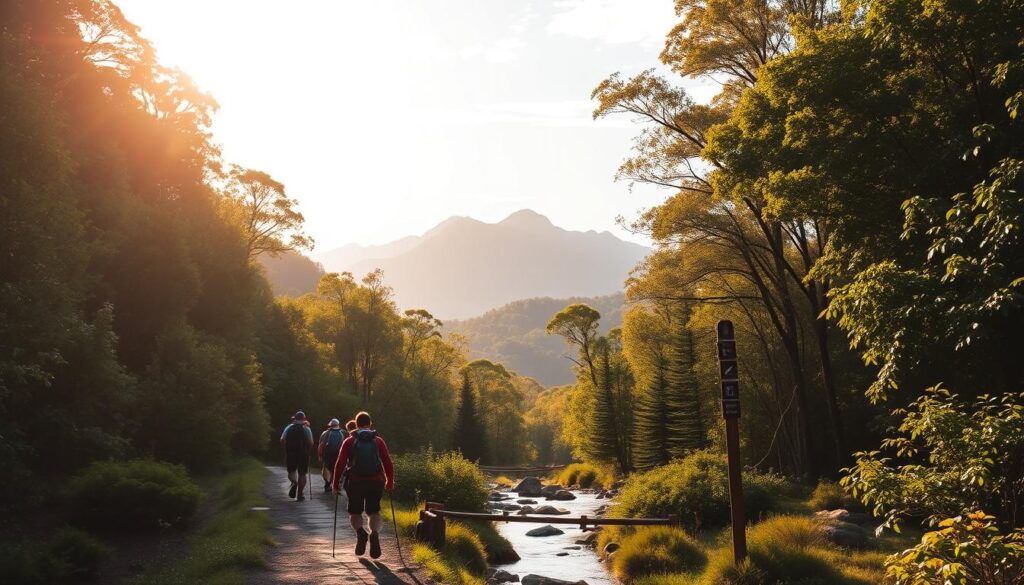
By being prepared and knowing these safety tips, you can enjoy your Blue Mountains adventure safely.
Eco-Friendly Camping Practices
The Blue Mountains are stunning, and we can keep them beautiful by camping responsibly. We must protect the environment and keep the natural beauty around us intact.
Leave No Trace Principles
Following the Leave No Trace guidelines is key to eco-friendly camping. These rules help us not harm the environment. They include:
- Planning ahead and preparing
- Traveling and camping on durable surfaces
- Disposing of waste properly
- Leaving what you find
- Minimizing campfire impacts
- Respecting wildlife
- Being considerate of other visitors
By sticking to these rules, we can greatly reduce our impact on nature. For example, using a portable stove instead of a campfire saves fuel and reduces fire risks.
How to Minimize Your Impact
To have a minimal impact while camping in the Blue Mountains, prepare well, stay aware, and act responsibly. Here are some useful tips:
Choose the Right Gear: Pick eco-friendly camping gear like reusable water bottles, biodegradable soap, and solar chargers. This cuts down on waste and reduces the need for frequent replacements.
Respect Wildlife: Keep a safe distance from animals and don’t feed them. This keeps the natural balance and stops animals from relying on human food.
Also, think about how much energy and waste you produce. Using a portable water filter or purification tablets can help avoid single-use plastic bottles.
By following these eco-friendly camping tips, we can help keep the Blue Mountains beautiful. This ensures it stays a great place for outdoor activities for everyone.
Local Attractions Beyond Hiking and Camping
The Blue Mountains have more to offer than just trails and campsites. There’s a world of attractions that show off the region’s beauty, history, and culture.
Scenic Lookouts and Natural Wonders
The Blue Mountains are full of scenic lookouts with stunning views. Some top spots include:
- Echo Point: Famous for its views of the Three Sisters rock formation.
- Govetts Leap: Offers panoramic views of the Grose Valley.
- Blackheath Gorge: A picturesque spot with stunning views.
For those who love natural wonders, the Blue Mountains have caves, waterfalls, and unique rock formations.
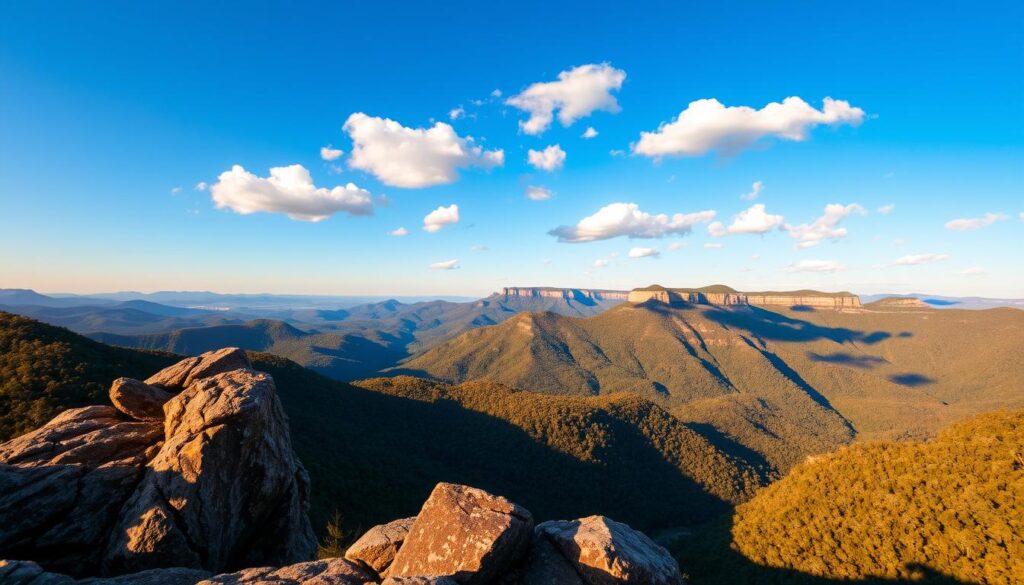
Historical Sites and Cultural Experiences
The Blue Mountains are not just for nature lovers. They also have a rich history and culture. Some highlights include:
- The Norman Lindsay Gallery, which showcases the works of the renowned Australian artist.
- The Blue Mountains Cultural Centre, giving insights into the region’s history and art.
- Indigenous cultural tours, where you can learn about the local Aboriginal heritage.
These attractions give a deeper look into the Blue Mountains’ significance.
In conclusion, the Blue Mountains offer something for everyone. Whether you’re into scenic views, natural wonders, history, or culture, this place will captivate and inspire you.
Preparing for Your Trip
Planning your trip to the Blue Mountains is essential. It can turn a good trip into a great one. Make sure you’re well-prepared for a safe and fun camping and hiking adventure.
Creating an Itinerary
Having a detailed itinerary is vital. It keeps you on track and ensures you enjoy your time. It also allows for flexibility if things change unexpectedly.
- Identify your interests: Think about what you want to do most. Do you love hiking, camping, or exploring?
- Choose your trails and campsites: Pick trails and campsites that match your interests and skill level.
- Plan your daily activities: Make a daily plan. Include your hiking, camping, and other activities you want to do.
Transportation Options to the Mountains
Getting to the Blue Mountains is easy. You have several ways to get there.
- By Car: Driving is the most convenient way. It takes about two hours from Sydney via the M4 motorway.
- Public Transport: Trains and buses run regularly from Sydney. You can take a train to Katoomba Station, a key spot in the Blue Mountains.
- Tour Services: Some tour operators offer transport as part of their packages.
Conclusion and Final Thoughts
As you get ready for your Blue Mountains adventure, planning is essential. With the right gear and knowledge, you’re set for an unforgettable journey. Understanding the local wildlife will also add to your experience.
Planning Your Next Adventure
For a great Blue Mountains Adventure Guide, check out local resources and planning tools. They’ll help you enjoy the best camping spots and hiking trails.
Expert Blue Mountains Camping Tips
Learn Blue Mountains Camping Tips to improve your camping. This includes setting up a safe campsite and being ready for weather changes.
Staying Connected
Connect with local communities and outdoor fans on social media and forums. It makes your trip better and gives you tips from those who’ve been there before.
FAQ
What is the best time to visit the Blue Mountains for camping and hiking?
Spring (September to November) and autumn (March to May) are the best times. The weather is mild, perfect for outdoor fun.
What are the essential items to pack for camping in the Blue Mountains?
Pack a good tent, sleeping bag, and cooking gear. Don’t forget safety items and clothes for the season. Bring a map, first aid kit, and be ready for weather changes.
Are there any hiking trails in the Blue Mountains suitable for beginners?
Yes, there are easy trails for beginners. Try the Valley of the Waters Circuit or the Jamison Valley Track. They offer beautiful views and are great for starting out.
What are the most popular campgrounds in the Blue Mountains?
Euroka Clearing, Blue Gum Flat, and Murphys Glen are top picks. They have amenities and are close to attractions.
How can I minimize my impact on the environment while camping and hiking in the Blue Mountains?
Follow Leave No Trace principles. Dispose of waste right, don’t disturb wildlife, and stay on trails. This helps keep the Blue Mountains beautiful.
What safety precautions should I take when hiking in the Blue Mountains?
Be ready for weather changes, carry a map, and have a first aid kit. Tell someone your plans and when you’ll be back.
Can I bring my pets on hiking trails in the Blue Mountains?
Some trails allow pets, but check the rules first. Most trails keep pets out to protect wildlife.
What are some must-see attractions in the Blue Mountains beyond hiking and camping?
See the Three Sisters, Govetts Leap, and the Norman Lindsay Gallery. They show the region’s beauty and history.

